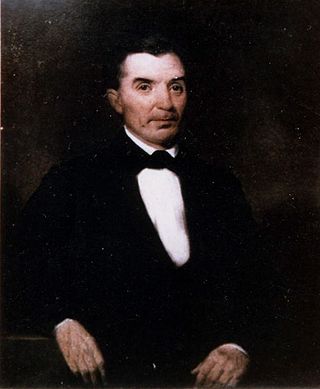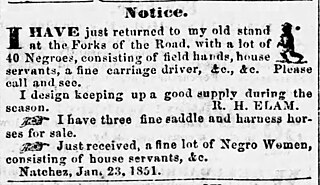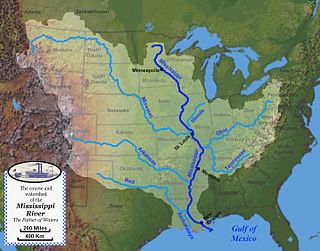
Natchez is the only city in and the county seat of Adams County, Mississippi, United States. The population was 14,520 at the 2020 census. Located on the Mississippi River across from Vidalia in Concordia Parish, Louisiana, Natchez was a prominent city in the antebellum years, a center of cotton planters and Mississippi River trade.

The internal slave trade in the United States, also known as the domestic slave trade, the Second Middle Passage and the interregional slave trade, was the mercantile trade of enslaved people within the United States. It was most significant after 1808, when the importation of slaves from Africa was prohibited by federal law. Historians estimate that upwards of one million slaves were forcibly relocated from the Upper South, places like Maryland, Virginia, Kentucky, North Carolina, Tennessee, and Missouri, to the territories and then-new states of the Deep South, especially Georgia, Alabama, Louisiana, Mississippi, and Arkansas.

Isaac Franklin was an American slave trader and plantation owner. He was the co-founder of Franklin & Armfield, which became the largest slave trading firm in the United States. Based in Alexandria, Virginia, it also had offices in Natchez, Mississippi; New Orleans and other Louisiana cities. Franklin owned a total of six plantations in Tennessee and Louisiana. His Fairvue plantation, in Gallatin, Sumner County, Tennessee, was formerly listed on the National Register of Historic Places.
John Armfield (1797–1871) was an American slave trader. He was the co-founder of Franklin & Armfield, "the largest slave trading firm" in the United States. He was also the developer of Beersheba Springs, Tennessee, and a co-founder of Sewanee: The University of the South.

The Franklin and Armfield Office, which houses the Freedom House Museum, is a historic commercial building in Alexandria, Virginia. Built c. 1810–1820, it was first used as a private residence before being converted to the offices of the largest slave trading firm in the United States, started in 1828 by Isaac Franklin and John Armfield. "As many as [a] million people are thought to have passed through between 1828 and 1861, on their way to bondage in Mississippi and Louisiana". Another source, using ship manifests in the National Archives, gives the number as "at least 5,000".

Slave breeding was the practice in slave states of the United States of slave owners to systematically force the reproduction of slaves to increase their profits. It included coerced sexual relations between male slaves and women or girls, forced pregnancies of female slaves, and favoring women or young girls who could produce a relatively large number of children. The objective was to increase the number of slaves without incurring the cost of purchase, and to fill labor shortages caused by the abolition of the Atlantic slave trade.
A coffle, sometimes called a platoon or a drove, was a group of enslaved people chained together and marched from one place to another by owners or slave traders.
Slave-Trading in the Old South by Frederic Bancroft, an independently wealthy freelance historian, is a classic history of domestic slave trade in the antebellum United States. Among other things, Bancroft discredited the assertions, then common in Ulrich B. Phillips-influenced histories of antebellum America, that slave traders were reviled outcasts and that slave trading was a rare exigency. Bancroft's book "provides still unrivalled profiles of great numbers of traders, many of whom he found to have the highest social standing."

Slave markets and slave jails in the United States were places used for the slave trade in the United States from the founding in 1776 until the total abolition of slavery in 1865. Slave pens, also known as slave jails, were used to temporarily hold enslaved people until they were sold, or to hold fugitive slaves, and sometimes even to "board" slaves while traveling. Slave markets were any place where sellers and buyers gathered to make deals. Some of these buildings had dedicated slave jails, others were negro marts to showcase the slaves offered for sale, and still others were general auction or market houses where a wide variety of business was conducted, of which "negro trading" was just one part.

Theophilus Freeman was a 19th-century American slave trader of Virginia, Louisiana and Mississippi. He was known in his own time as wealthy and problematic. Freeman's business practices were described in two antebellum American slave narratives—that of John Brown and that of Solomon Northrup—and he appears as a character in the 2013 film dramatization of Northrup's Twelve Years a Slave.

William A. Pullum was a 19th-century American slave trader, and a principal of Griffin & Pullum. He was based in Lexington, Kentucky, and for many years purchased, imprisoned, and shipped enslaved people from Virginia and Kentucky south to the Forks-of-the-Road slave market in Natchez, Mississippi.

Thomas McCargo, also styled Thos. M'Cargo, was a 19th-century American slave trader who worked in Virginia, Kentucky, Mississippi and Louisiana. He is best remembered today for being one of the slave traders aboard the Creole, which was a coastwise slave ship that was commandeered by the enslaved men aboard and sailed to freedom in the British Caribbean. The takeover of the Creole is considered the most successful slave revolt in antebellum American history.

Samuel Stillman Boyd, often called S. S. Boyd or Judge Boyd, was an esteemed attorney of early 19th-century Mississippi, as well as a judge (briefly), political party leader, cotton-agriculture investor, real estate speculator, large-scale enslaver, and pro-slavery activist. Boyd seems to have been politically influential in his community, initially as a Whig Party leader. Boyd's name was floated in both 1852 and 1860 as a candidate to fill an empty seat on the U.S. Supreme Court.

George Kephart was a 19th-century American slave trader, land owner, farmer, and philanthropist. A native of Maryland, he was an agent of the interstate trading firm Franklin & Armfield early in his career, and later occupied, owned, and finally leased out that company's infamous slave jail in Alexandria. In 1862, Henry Wilson of Massachusetts mentioned Kephart by name in a speech on the floor of the U.S. Senate as one of the traders who had "polluted the capital of the nation with this brutalizing traffic" of selling people.

Jonathan Means Wilson, usually advertising as J. M. Wilson, was a 19th-century slave trader of the United States who trafficked people from the Upper South to the Lower South as part of the interstate slave trade. Originally a trading agent and associate to Baltimore traders, he later operated a slave depot in New Orleans. At the time of the 1860 U.S. census of New Orleans, Wilson had the second-highest net worth of the 34 residents who listed their occupation as "slave trader".

Poindexter & Little was a 19th-century American slave-trading company with operations in Tennessee and Louisiana. The principals were likely Thomas B. Poindexter, John J. Poindexter, Montgomery Little, William Little, Chauncey Little, and Benjamin Little. The Littles were brothers; the Poindexters were most likely brothers but possibly cousins. At the time of the 1860 census, Thomas B. Poindexter had the highest declared net worth of any person who listed their occupation as a slave trader in New Orleans. In 1861 they had a slave depot located at 48 Baronne in New Orleans.

Seth Woodroof was a slave trader based in Lynchburg in central Virginia, United States. He was an interstate trader who ran what the Lynchburg Museum called the "most active and infamous" slave pen in the city. He is believed to have been actively trading from approximately 1830 until the beginning of the American Civil War in 1861. Woodroof sat on the Lynchburg city council from 1858 to 1865.

Robert H. Elam, usually advertising as R. H. Elam, was an American interstate slave trader who worked in Tennessee, Kentucky, Louisiana, and Mississippi.

Griffin & Pullum, later Griffin, Pullum & Co., was a 19th-century American interstate slave-trading company. The principals were Pierce Griffin and William A. Pullum. They mainly bought people in Kentucky and sold them in Mississippi.

















